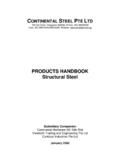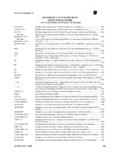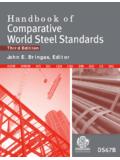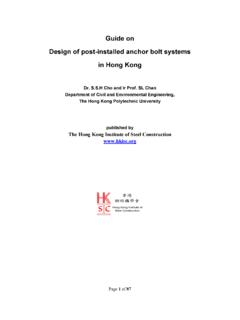Transcription of 100% Stainless
1 AVESTA FINISHING CHEMICALS / PICKLING HANDBOOK1100% StainlessPICKLING HANDBOOKS urface treatment of Stainless steelsAVESTA FINISHING CHEMICALS / PICKLING HANDBOOK2 FOREWORD 41 Stainless steel AND THE NEED FOR CLEANING 5 Stainless steel grades and cleaning 6 Surface finishes and cleaning 8 Welding methods and cleaning 10 Correct handling and cleaning 10 Industrial trends and cleaning 10 Typical defects 11 Heat tint and oxide scale 11 Weld defects 11 Iron contamination 11 Rough surface 11 Organic contamination 112 CLEANING PROCEDURES 12 Mechanical methods 12 Grinding 12 Blasting 12 Brushing 13 Summary 13 Chemical methods 13 Pickling 13 Passivation and decontamination 14 Electropolishing 14 Choice of method 15 A complete cleaning process 16 Case details 163 CHEMICAL METHODS IN PRACTICE 17 Avesta Products 17 General requirements 17 Precleaning/degreasing 18 Pickling 19 Pickling with paste 19 Pickling with solution 19 Typical pickling times for brush and spray pickling 20 Pickling in a bath
2 22 Fume reduction during pickling 23 Passivation and desmutting 244 NEUTRALISATION AND WASTE TREATMENT 25 Neutralisation 25 Waste treatment 255 INSPECTION AND TROUBLESHOOTING 26 Test methods 26 Troubleshooting 266 SAFE HANDLING AND STORAGE OF PICKLING PRODUCTS 28 Safety rules 28 Personal safety 28 Storage 29 REFERENCES 30 DISCLAIMER 31 INDEXA uthor: Anders Bornmyr, Avesta Finishing ChemicalsCo-authors: Josef Toesch and Franz Winkler, B hler Welding GmbH B hler Welding Group Nordic AB All rights reserved.
3 No part of this publication may be reproduced, stored in a retrieval system, or be transmitted in any form or by any means, electronic, mechanical, photocopying, recording or otherwise without the prior permission of B hler Welding Group Nordic in Sweden by Centrumtryck, AvestaFirst edition 1995 Second edition (significant updates) 2009 AVESTA FINISHING CHEMICALS / PICKLING HANDBOOK3 BeforeAfterAVESTA FINISHING CHEMICALS / PICKLING HANDBOOK4 ForewordThis manual is intended to increase awareness and understanding of the need to treat Stainless steel surfaces.
4 In particular, it aims to: Explain why, after welding and processing, Stainless steel structures need cleaning in order to preserve their corrosion resistance. Show, through a survey of typical defects, when cleaning is important. Describe how to clean using different cleaning techniques. Give practical recommendations and instructions as to what to do in order to eliminate typical this manual, Avesta Finishing Chemicals presents practical methods for pickling and cleaning Stainless steels. Appropriate safety procedures when handling the products concerned are also set Finishing Chemicals is a leading producer of superior pickling products for stain-less steels and special alloys.
5 The company is also part of the B hler Welding Group, one of the world s largest manufacturers of welding FINISHING CHEMICALS / PICKLING HANDBOOK5 Stainless steels and the need for cleaningA good Stainless steel surface is clean, smooth and fault-less. The importance of this is obvious when Stainless steel is used in, for example, fa ades or applications with stringent hygiene requirements. However, a fine surface finish is also crucial to corrosion steel is protected from corrosion by its passive layer a thin, impervious, invisible, surface layer that is primarily chromium oxide.
6 The oxygen content of the atmosphere or of aerated aqueous solutions is normally sufficient to create and maintain ( self-heal ) this passive layer. Unfortunately, surface defects and imperfections introduced during manufacturing may drastically dis-turb this self-healing process and reduce resistance to several types of local corrosion. Thus, as regards hygiene and corrosion, a final cleaning process is often required to restore an acceptable surface extent of, and methods for, post-fabrication treat-ment are determined by a number of factors.
7 These include: the corrosivity of the environment ( marine); the corrosion resistance of the steel grade; hygiene re-quirements ( in the pharmaceutical and food indus-tries); and, aesthetic considerations. Local environmental requirements must also be considered. Both chemical and mechanical cleaning methods are design, planning and methods of manufacture can reduce the need for post-treatment and thus lower costs. When manufacturing to surface quality specifications, the impact of defects and, ultimately, the cost of removal must be borne in cost of treating/cleaning is small compared to the initial capital expenditure on a piece of equipment.
8 It is also small compared to the continuing operational cost of not are two main elements in the economics of post-fabrication cleaning the cost of cleaning and the benefits that cleaning brings as regards long-term per-formance. Fabrication can reduce the overall corrosion performance of a Stainless steel to below its normal level. Furthermore, in real conditions, it is difficult, if not impossible, to complete the fabrication of a significant facility or piece of equipment without some surface they generally have relatively poor corrosion performance, areas that have not been cleaned after fabrication are essentially the weak link in the chain.
9 Depending on the extent of cleaning required, treatment after constructing a tank (for example) might cost as little as 1 3% of the total spent on materials and manu-facture. Consequently, as it maximises the return on the investment, post-fabrication cleaning is not expensive (see also ref. 9). 1: Before and after picklingFigure 2: Treated and untreated Stainless steel tanksAVESTA FINISHING CHEMICALS / PICKLING HANDBOOK6 DefinitionsThe following terms are often imprecisely used: clean-ing; post-fabrication cleaning; precleaning; descaling; pickling; passivation; and, desmutting.
10 For a better understanding of surface treatment and this publica-tion, it is important to define these includes all operations necessary to ensure the removal of surface contaminants from metals and: Maximise the metal s corrosion resistance. Prevent product contamination. Achieve the desired of grinding, degreasing, pickling and passivation may be necessary to obtain a clean cleaning is the process of cleaning after fabrication. Its purpose is to remove all contami-nation associated with the fabrication is the removal of grease, oil, paint, soil, grit and other coarse contamination prior to pickling or final is the removal of grease prior to pickling or final is the use of chemicals to clean a metal by removing: defects; the surface film of inherent or thick-ened oxide; and, below this, some micrometres of the parent is a too strong etching of a surface with pickling acids.






